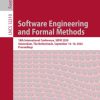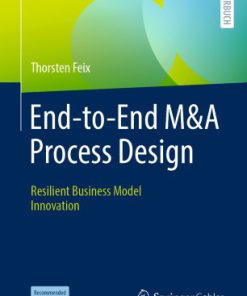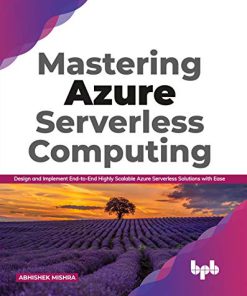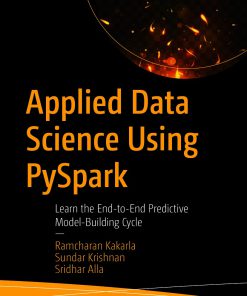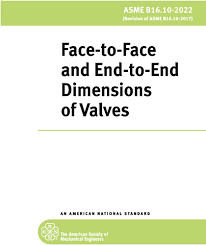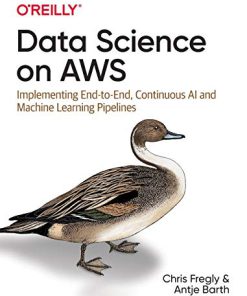Making Sense of Sensors 1st Edition by Omesh Tickoo, Ravi Iyer ISBN 1430265930 9781430265931
$50.00 Original price was: $50.00.$25.00Current price is: $25.00.
Making Sense of Sensors 1st Edition by Omesh Tickoo, Ravi Iyer – Ebook PDF Instant Download/Delivery: 1430265930, 978-1430265931
Full download Making Sense of Sensors 1s Edition after payment
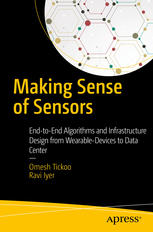
Product details:
ISBN 10: 1430265930
ISBN 13: 978-1430265931
Author: Omesh Tickoo, Ravi Iyer
Make the most of the common architectures used for deriving meaningful data from sensors. This book provides you with the tools to understand how sensor data is converted into actionable knowledge and provides tips for in-depth work in this field.
Making Sense of Sensors starts with an overview of the general pipeline to extract meaningful data from sensors. It then dives deeper into some commonly used sensors and algorithms designed for knowledge extraction. Practical examples and pointers to more information are used to outline the key aspects of Multimodal recognition. The book concludes with a discussion on relationship extraction, knowledge representation, and management.
In today’s world we are surrounded by sensors collecting various types of data about us and our environments. These sensors are the primary input devices for wearable computers, IoT, and other mobile devices. The information is presented in way that allows readers to associate theexamples with their daily lives for better understanding of the concepts.
What You’ll Learn
- Look at the general architecture for sensor based data
- Understand how data from common domains such as inertial, visual and audio is processed
- Master multi-modal recognition using multiple heterogeneous sensors
- Transition from recognition to knowledge through relationship understanding between entities
- Leverage different methods and tools for knowledge representation and management
Who This Book Is For
New college graduates and professionals interested in acquiring knowledge and the skills to develop innovative solutions around today’s sensor-rich devices.
Making Sense of Sensors 1s Table of contents:
Chapter 1: Introducing the Pipeline
- Motivation: Introduction to the need for efficient data processing pipelines in recognition tasks.
- Next Level of Data Abstractions: Discussing advanced data models and abstractions for recognition systems.
- Operations: Key operations used in the recognition pipeline.
- Constraints and Parameters: Overview of factors like resource limitations and system constraints.
- Physical Platforms: The role of physical platforms (hardware) in data processing and recognition.
- Summary: Key points and takeaways.
- References: Relevant citations and sources.
Chapter 2: From Data to Recognition
- Sensor Types and Levels of Recognition: Different sensors (inertial, audio, visual) and how they contribute to recognition.
- Inertial Measurement Unit (IMU): Details about accelerometers, gyroscopes, and their role in gesture recognition.
- Audio Sensors: Covers audio classification, voice activity detection, and speech recognition (ASR, NLP).
- Visual Sensors: Object and gesture recognition, video summarization.
- Other Sensors: Overview of additional sensors like proximity, location, and chemical sensors.
- Summary: Recap of the key technologies in data collection for recognition.
- References: Relevant sources and citations.
Chapter 3: Multimodal Recognition
- Why Multi-modality: The benefits of combining multiple sensor types (audio, visual, etc.) for improved recognition.
- Multimodality Flavors: Various models for combining sensor data.
- Coupling-based Classification: Combining data streams for classification.
- Dasarathy Model: A specific framework for multimodal recognition.
- Sensor Configuration Model: Different ways to configure and integrate sensors.
- Example Implementations: Real-world applications and case studies.
- Semantic Fusion, Tight Fusion, Restricted Recognition: Methods for fusing multimodal data.
- Mathematical Approaches for Sensor Fusion: Different approaches for sensor fusion, including estimation and inferencing.
- Summary: Key points about the importance and methods of multimodal recognition.
- References: Citations for further reading.
Chapter 4: Contextual Recognition
- Relationship between Context and Recognition: How context enhances recognition accuracy.
- Rule-based Systems, Knowledge-based Systems: Approaches for incorporating context into machine learning systems.
- Understanding Context: Roles that context plays in improving recognition.
- Incorporating Context in Recognition: Methods for embedding context in recognition systems.
- Motivation from Human Recognition: Drawing parallels from human perception to improve machine recognition.
- Image-based and Non-image-based Contextual Recognition: Different ways context can be utilized in recognition tasks.
- Representing Context: Strategies for representing contextual information computationally.
- Summary: Overview of how context improves recognition systems.
- References: Further reading on contextual recognition.
Chapter 5: Extracting and Representing Relationships
- High-level View of Relationship Extraction: How relationships are identified and represented from data, particularly text.
- Relationship Extraction Methods:
- Knowledge-based Methods: Domain-dependent and independent approaches to relationship extraction.
- Supervised Methods: Feature-based and kernel-based techniques for extracting relationships.
- Semi-supervised Methods: Techniques like DIPRE, Snowball, and KnowItAll for extracting relationships with limited labeled data.
- NEIL (Never Ending Image Learning): A method for continuously learning relationships from images.
- Summary: Key methods and challenges in relationship extraction.
- References: Relevant resources.
Chapter 6: Knowledge and Ontologies
- Relationship Representation using RDF: How relationships can be represented using Resource Description Framework.
- Databases and Knowledge Graphs: Overview of databases that store relationships (e.g., Freebase, ConceptNet, Google’s Knowledge Graph).
- Semantic Web and Ontologies: Importance of ontologies in representing structured knowledge.
- Ontology Components and Languages: Details of the structure and language used for defining ontologies.
- Summary: Recap of the role of ontologies and knowledge bases in improving recognition systems.
- References: Key references for further reading.
Chapter 7: End-to-End System Architecture Implications
- Platform Data Processing Considerations: Factors such as compute power, battery life, memory, and interactivity that influence platform design.
- End-to-End System Partitioning and Architecture: Overview of how data processing tasks are distributed across various platforms (sensor nodes, wearable, phone, gateway, cloud).
- End-to-End Processing & Mapping Examples: Case studies demonstrating the mapping of different types of data processing (speech, visual, etc.).
- Programmability Considerations for End-to-End Partitioning: Programming challenges and solutions for distributed systems.
- Summary and Future Opportunities: Overview of challenges and potential future developments.
- Conclusion: Closing thoughts on the evolving field of recognition systems.
- References: Further citations for deeper exploration.
People also search for Making Sense of Sensors 1s :
sensor making process
how do sensors sense
sense-making process
making sense of sensemaking
synthetic sensors towards general-purpose sensing
Tags:
Omesh Tickoo,Ravi Iyer,Making,Sense,Sensors 1s
You may also like…
Business & Economics - Personal Finance
End-to-End M&A Process Design: Resilient Business Model Innovation Thorsten Feix
Biology and other natural sciences
Computers - Programming
A Common Sense Guide to Data Structures and Algorithms 1st Edition Jay Wengrow
Computers - Computer Science
Engineering - Chemical Engineering
ASME B16.10-2022 Face to face and end to end dimensions of valves 2023rd Edition Asme
Computers - Computer Science



